| Start of section
Production, amateur Radio amateurs Aircraft model, rocket-model Useful, entertaining |
Stealth Master
Electronics Physics Technologies Inventions |
Secrets of the cosmos
Secrets of the Earth Secrets of the Ocean Tricks Map of section |
|
| Use of the site materials is allowed subject to the link (for websites - hyperlinks) | |||
Navigation: => |
Home / Patent catalog / Catalog section / Back / |
|
INVENTION
Patent of the Russian Federation RU2222711
![]()
HYDROPOWER STATION
The name of the inventor: Soloviev Vladimir Vladimirovich
The name of the patent holder: Soloviev Vladimir Vladimirovich
Address for correspondence: 125015, Moscow, ul. Butyrskaya, 97, ap.140, to V.V. Solovyov
Date of commencement of the patent: 2000.08.01
The invention is intended for converting the energy of water flows into electricity. The hydroelectric power plant contains a water intake casing installed in the stream near the shore with an upper inclined, lateral and lower bottom walls, with a cross-section decreasing in flow. The box is provided at the entrance with protective grids and is connected to a rectangular cross-section water conduit made up of docking, rotary, exhaust, and unified operating elements into a shuttered opening in the side wall of which the working blades of vertical-axial capsule hydraulic units are equipped with devices for regulating and Stabilization of the number of revolutions of capsules and working chambers with a cut in cylindrical casings, mounted detachably on movable platforms, moving by means of electric motors and mechanisms installed in sealed compartments, along support platforms attached to working elements of the water conduit. The device for regulation and stabilization of the number of revolutions of the capsules of hydroelectric units is connected by electric cables with electric motors of the moving mechanisms to the base of movable platforms installed in sealed compartments attached to the side wall of the working element of the water conduit. The opening in the side wall of the working element has a width equal to the diameter of the cylindrical body of the working chamber and a height equal to the inner height of the side wall of the working element. The opening in the side wall of the working element includes the upper and lower profile bars, to which a damper covering the opening in the side wall of the working element of the water conduit is attached from inside the water conduit and which are fixed to profile struts symmetrically attached to the movable platform and congruently contacting the vertical wall of the cylindrical body Working chamber, the width of the cutout is equal to the distance between these racks, and to the walls of hermetically sealed compartments in which the movable platform mechanisms and electric motors are placed and which are oriented perpendicular to the side wall of the working element. The distance between the walls of the sealed compartments is equal to the diameter of the cylindrical body of the working chamber. The design of the hydroelectric power station makes it possible to increase its power.
DESCRIPTION OF THE INVENTION
The invention relates to the field of hydropower engineering and can be used to convert the kinetic energy of water flows with different flow velocities into electricity, including relatively small ones.
A hydroelectric power station (HPP) is known, which includes a water intake duct installed in the stream at the shore with bottom, top and side walls, with a cross-section decreasing in flow, connected to water conduits composed of working, rotary and docking elements, with working chambers and capsules placed in them Hydraulic aggregates (see copyright certificate of the USSR 1652640 A1, IPC 7 F 03 B 13/08, 30.05.1991).
This known hydroelectric power plant has a complicated design caused by the placement of capsular hydraulic units directly in the water lines and the need therefore to have at least two waterways in the structure, limited power caused by the use of horizontal capsule hydraulic units, limited reliability, and a limited field of application caused by relative inefficiencies in the application Hydroelectric power plants on lowland rivers with a low flow rate and low flow.
The closest in terms of technical essence to the proposed invention is the "VOLSLOV" hydroelectric power station, which incorporates a protective grid installed at the inlet near the shore, oriented at an angle to the direction of flow, with an upper inclined, lateral and lower bottom walls, Flow cross-section, connected to a rectangular cross-sectional water conduit made up of rotary, docking and unified operating elements in the side wall of which a shuttered opening is made, into which the working blades of vertical-axial capsule hydraulic units are provided equipped with devices for regulating and stabilizing the number of capsules And placed in the cylindrical bodies of working chambers with a cut, installed detachably on movable platforms, moving by means of electric motors and mechanisms installed in sealed compartments, along the support platforms attached to the working elements of the water conduit (see Fig. Patent of the Russian Federation 2140012 C1, IPC 7 F 03 B 13/00, 20.10.1999).
However, this hydroelectric power plant has a limited field of application, caused by its inefficient use on streams with a relatively low flow speed, since to ensure its efficient operation, the dimensions of the intake duct must be large, relatively small, due to a relatively small water intake and flow, and relative complexity The structure is caused by the presence of guiding blades in the working elements of the water conduit, dampers fixed on the protrusions moving in the grooves in the lower walls of the working elements, and hermetically sealed compartments with servomotors and arc-bars.
The object of the present invention is to expand the field of application, simplify the design and increase the capacity of the hydroelectric power plant.
This technical result is achieved due to the fact that the hydroelectric power station includes an intake manifold installed in the stream at the bank with an upper inclined, lateral and lower bottom wall, with a flow cross-section decreasing in flow, provided with protective grids at the inlet, connected to a rectangular cross-sectional water conduit made up of Docking, rotary, exhaust, and unified working elements, in the side wall of which a shuttered aperture is made, into which the working blades of vertical-axial capsular hydrounits are provided, equipped with devices for regulating and stabilizing the number of revolutions of the capsules and placed in the cylindrical bodies of working chambers with a cutout , Installed detachably on moving platforms, moving with the help of electric motors and mechanisms installed in sealed compartments, along the support platforms, attached to the working elements of the water conduit. The device for regulating and stabilizing the speed of the capsules of the hydroelectric units is connected by electric cables to the motors of the moving mechanisms on the base of the movable platforms installed in sealed compartments attached to the side wall of the working element of the water conduit; the opening in the side wall of the working element has a width equal to the diameter of the cylindrical body of the working chamber, And a height equal to the inner height of the sidewall of the working element, the upper and lower profile laths are inserted into the opening in the side wall of the working element, to which a damper covering the opening in the sidewall of the working element of the water conduit is attached from inside the water conduit and which are fixed to profile posts symmetrically attached To the movable platform and congruently contacting the vertical wall of the cylindrical body of the working chamber, the width of the cutout is equal to the distance between these racks, and to the walls of the hermetic compartments in which the movable platform's mechanisms and electric motors are placed and which are oriented perpendicular to the side wall of the working element, The distance between the walls of the sealed compartments is equal to the diameter of the cylindrical body of the working chamber.
 |
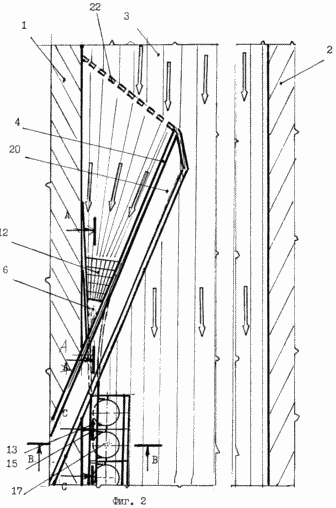 |
1 schematically shows a general top view of the proposed HPP in the embodiment of a dam between the first and second sides of the flow; FIG. 2 schematically shows a general view of the proposed HPP in an embodiment of a dam between the first bank and the flow path.
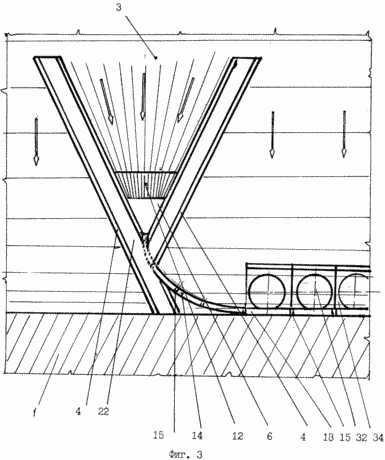 |
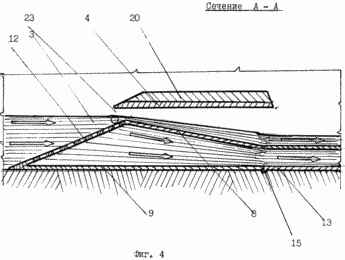 |
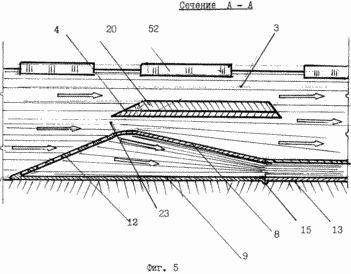 |
FIG. 3 is a schematic general view from above of the proposed HPP in the version of the use of large water bodies offshore; FIG. 4 is a sectional view AA of FIG. 1 and FIG. 2 in a variant of HPP operation under conditions of meager waters. FIG. 5 is a cross-sectional view AA of FIG. 1 and 2 in the version of HPP operation in conditions of flood waters and ice drift.
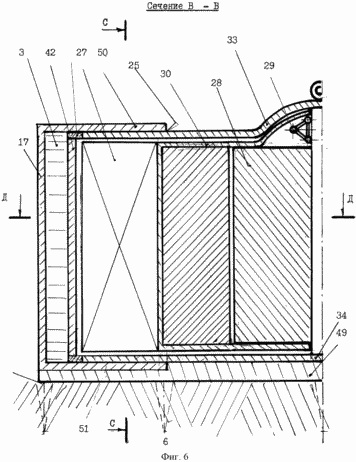 |
 |
|
FIG. 6 is a cross-sectional view taken along line B-B of FIG. 1, FIG. 7 is a cross-sectional view of the C-C view of FIGS. 1, 2 and FIG. 6, FIG. 8 is a sectional view DD of FIG. 6. FIG. The proposed HPP includes a stream 3 flowing between the banks 1 and 2 and oriented upstream 3 at an acute angle to the flow direction 3 of the dam 4 with an opening 5 at the shore 1 in which an intake 6 with a bottom 7, a top 8, a bottom 9 and side 10 and 11 with walls provided at the inlet oriented at an acute angle to the bottom wall 7 by a protective grid 12 and connected to a water conduit 13 of a rectangular cross section made up of rotary 14, coupling 15, outlet 16a, and unified operating elements 17. At the shore 2, the dam 4 is provided with an opening 18, between which and the first bank 1 there is a guard 19. In the embodiment with two apertures 5 and 18, the dam 4 is provided with a road surface 20. In the version with the duct 21, the dam 4 is provided with a guard 22 installed between the duct 21 and the first bank 1. A drain hole 23 is provided in the opening 5 above the water intake duct 6. In the variant of application at the banks of large reservoirs, the water intake box 6 is installed in a stream of 3 waves near the shore of 1 large reservoir between two symmetrically dipping at a sharp angle at the shore 1 by dams 4, oriented with an expansion at an acute angle against the flow of 5 waves moving to shore 1; While the intake duct 6 is smoothly connected by means of pivoting and docking elements to a water conduit 13 oriented along the edge of the shore 1. | |
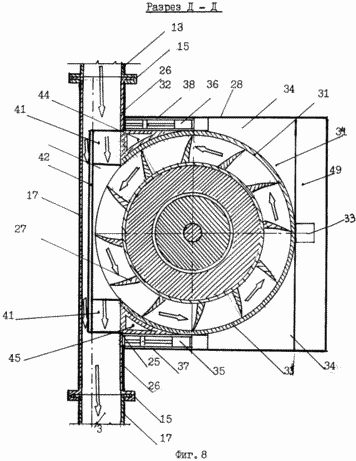 |
In the opening 25 of the side wall 26 of the unified working elements 17 of the water conduit 13 are the working blades 27 of the vertical axial capsule hydroelectric units 28 provided with devices 29 for automatically adjusting and stabilizing the speed of the capsule 30 at a predetermined level and housed in cylindrical bodies 31 with a cutout 32 of the working chambers 33 Mounted on movable platforms 34 moving by means of displacement motors 35 and 36 mounted in sealed compartments 37 and 38 attached to movable platforms 34 and side walls 26; The device 29 for regulating and stabilizing the number of revolutions of the capsules 30 of the hydroelectric units 28 is connected by electric cables 39 to the movers 35 and 36 of the moving platforms 34; The opening 25 in the side wall 26 of the working member 17 has a width equal to the diameter of the cylindrical body 31 of the working chamber 33 and a height equal to the inner height of the sidewall 26 of the water conduit operating member 17, the upper 40 and top 40 enter into the opening 25 in the side wall 26 of the working member of the water conduit 17 Lower 41 profile bars to which a damper 42 is attached from inside the water conduit moving between the upper 50 and lower 51 walls of the water conduit operating member 17 and overlapping the opening 25 in the side wall 26 of the working member 17 of the water conduit 17 and which are attached to the profile posts 43 and 44 symmetrically attached To the movable platform 34 and congruently contacting the vertical wall 45 of the cylindrical body 31 of the working chamber 33, the width of the cutout 32 in which is equal to the distance between the profile legs 44 and 43 and to the walls 46 and 47 of the hermetic compartments 37 and 38 in which the motors 35 and 36 of the movement mechanisms of the movable platform 34, and which are oriented perpendicularly to the side wall 26; The distance between the walls 47 and 48 of the hermetic compartments 37 and 38 is equal to the diameter of the cylindrical body 31 of the cooking chamber 33.
The proposed HPP operates as follows. Part of the stream 3, flowing at a speed V 1 passing through the guard 19, 22, is released partially from dangerous objects moving with the flow 3, falls into the zone of action of the dam 4 and, due to the decrease in the cross section of the flow, gradually increases its velocity to the speed V 2 , Which exceeds the velocity V 1 almost in multiples of the cross-sectional area ratio ![]() 1 at the inlet of the stream 3 into the dam 4 and the area of the dam
1 at the inlet of the stream 3 into the dam 4 and the area of the dam ![]() 2 of the cross-section of the flow 3 at the entrance to the opening 5 of the dam 4.
2 of the cross-section of the flow 3 at the entrance to the opening 5 of the dam 4.
The protective grate 12 at the entrance to the intake duct 6, oriented at an angle to the bottom wall 7, prevents the penetration of dangerous objects with the flow 3 into the intake duct 6, and due to the action of the horizontal component of the moving stream 3, they are carried out through the drain hole 23 in the opening 5 above the water intake box 6 beyond the protective grid 12 into the space below the dam 4.
Upon entering the water conduit, a part of the stream 3 in each operating element 17 of the water conduit 13 is divided into a working part 49 that successively rotates the capsule 30 of the hydroelectric units 28 and a free part 50 that passes freely through the working element 17 merging therein with the working portion 49 of the flow 3 And partially compensating for head losses in the working part 49.
The ratio of the cross sections of the working 49 and the free 50 parts of the flow in the working elements during design is selected optimal, ensuring the maximum possible power of the hydraulic unit 28 in each operating element 17 and repeatedly removing the power of the stream 3 moving in the water conduit 13 in the respective sections of the flow 3.
The smaller part of the stream 3 in the version of the HPP with the dam 4 and the two openings 5 and 18 in it freely passes with the initial speed V 1 through the opening 18 of the dam 4 and pours into the natural channel of the stream, creating the possibility of free migration of the river fauna and navigation. The pavement 20 on the dam 4 allows it to be used as a ferry across the stream 3 for almost the entire year, with the exception of a period of high water and ice drift.
During the freeze-up period, all parts of the HPP, except dam 4, are below the lower level of freeze-up. During the flood period, the dam 4 is temporarily flooded, ice 52 passes over the dam 4, without violating the operating mode of the hydroelectric power station.
The performance of the dam crossing 4 through the flow 3 allows to reduce the total cost of erecting a hydroelectric power station, excluding the cost of erecting a dam 4 as a ferry device.
The erection of one dam 4 can ensure the operation of a hydroelectric power station with a water conduit 13 of considerable length, a large number of operating elements 17 and hydrounits 28, with a high power, with its full ecological compatibility, i.e. Its operation without the flooding of floodplain lands, without erecting obstacles for the migration of river fauna and navigation.
The wide scope of application of the proposed hydroelectric power station and its high efficiency, simplicity of construction and technology of erection will enable to provide cheap electricity production both in many regions of Russia and in many other regions of the world.
CLAIM
A hydroelectric power station including a water intake casing installed in the stream at the shore with an upper inclined, lateral and lower bottom wall, with a cross-section decreasing in flow, provided with protective grids at the entrance, connected to a rectangular cross-section water conduit made up of docking, rotary, outlet, and Unified working elements in the side wall of which a shuttered opening is made, into which the working blades of vertical-axial capsule hydraulic units are provided, equipped with devices for regulating and stabilizing the number of revolutions of the capsules and working in the cylindrical bodies of working chambers with a cut, detachable on movable platforms, With the help of electric motors and mechanisms installed in hermetically sealed compartments along the support platforms attached to the working elements of the water conduit, characterized in that the device for regulating and stabilizing the speed of the capsules of the hydroelectric units is connected by electric cables with electric motors of the moving mechanisms to the base of movable platforms installed in sealed compartments, The opening in the side wall of the working element has a width equal to the diameter of the cylindrical body of the working chamber and the height equal to the inner height of the side wall of the working element, the upper and lower profile bars enter the opening in the side wall of the working element, To which a flap covering the opening in the side wall of the working element of the water conduit is fixed from inside the water conduit and which are attached to profile struts symmetrically attached to the movable platform and congruently contacting the vertical wall of the cylindrical body of the working chamber, the width of the cutout being equal to the distance between these racks, and With the walls of hermetically sealed compartments in which the movable platform moving mechanisms and motors are placed and which are oriented perpendicular to the side wall of the working element, the distance between the walls of the sealed compartments being equal to the diameter of the cylindrical body of the working chamber.
print version
Date of publication 12.01.2007gg




Comments
When commenting on, remember that the content and tone of your message can hurt the feelings of real people, show respect and tolerance to your interlocutors even if you do not share their opinion, your behavior in the conditions of freedom of expression and anonymity provided by the Internet, changes Not only virtual, but also the real world. All comments are hidden from the index, spam is controlled.